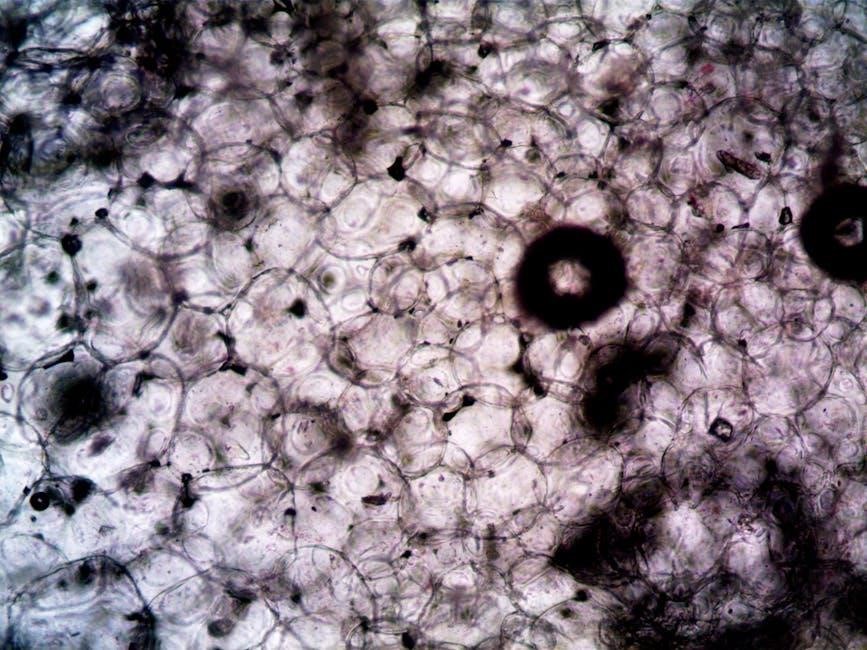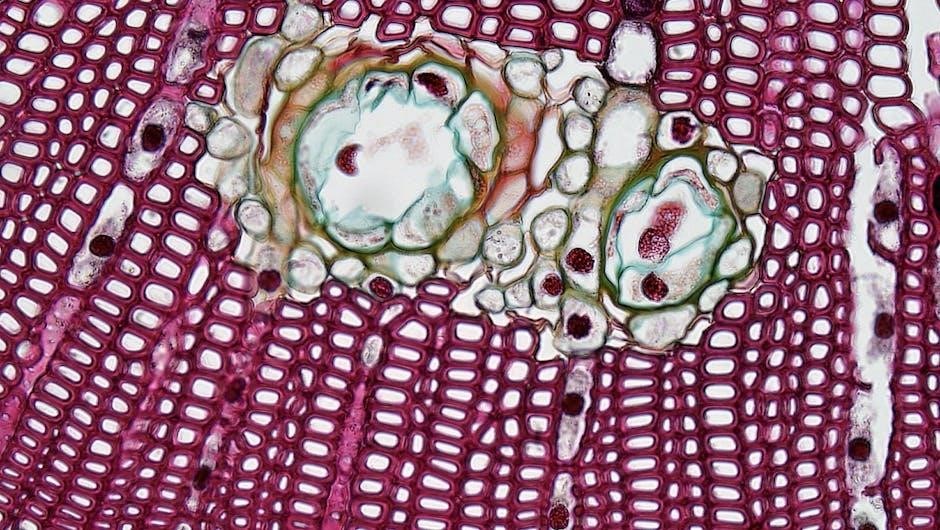Cell biology‚ or cytology‚ is the scientific study of cells‚ focusing on their structure‚ function‚ and organization. It explores the molecular and cellular basis of life‚ revealing how cells operate‚ interact‚ and contribute to organisms. This field is foundational for understanding biology and medicine‚ offering insights into life’s building blocks.
1.1 Key Concepts and Theories in Cell Biology
Cell biology is rooted in foundational theories such as the Cell Theory‚ which states that all life is composed of cells‚ cells are the basic units of life‚ and new cells arise from existing ones. The Fluid Mosaic Model describes the plasma membrane as a dynamic structure of lipids and proteins. Additionally‚ the Central Dogma outlines the flow of genetic information from DNA to proteins. These concepts form the backbone of cell biology‚ enabling scientists to study cellular structures‚ functions‚ and interactions. Modern advancements‚ including electron microscopy and molecular techniques‚ have refined these theories‚ deepening our understanding of cellular mechanisms and their significance in life processes.
1.2 Importance of Studying Cell Biology
Studying cell biology is essential for understanding the fundamental mechanisms of life‚ enabling advancements in medicine‚ agriculture‚ and biotechnology. By exploring cellular structures and processes‚ researchers uncover insights into disease origins‚ such as cancer and infections‚ leading to targeted therapies. Cell biology also informs strategies for improving crop yields and developing personalized treatments. Its applications extend to environmental science‚ aiding in understanding how organisms respond to ecological changes. Furthermore‚ studying cells enhances our knowledge of evolution‚ revealing how life forms adapt and diversify. This foundational understanding is crucial for addressing global health challenges and fostering technological innovation.

Cell Structure and Organization
Cell structure includes the plasma membrane‚ cytoplasm‚ and organelles like mitochondria‚ ribosomes‚ and the nucleus‚ organized to perform essential functions such as metabolism and reproduction efficiently.
2.1 Plasma Membrane: Structure and Function
The plasma membrane‚ also known as the cell membrane‚ is a semi-permeable lipid bilayer embedded with proteins. It encloses the cell‚ regulating the movement of substances in and out; Composed primarily of phospholipids and integral proteins‚ the membrane adheres to the fluid mosaic model‚ allowing dynamic movement of its components. Its functions include protecting the cell‚ facilitating communication through signaling molecules‚ and controlling the transport of ions‚ nutrients‚ and waste products via passive and active mechanisms. This structure is essential for maintaining cellular homeostasis and enabling interactions with the external environment‚ making it a critical component of cellular function and survival.
2.2 Comparison of Plant and Animal Cells
Plant and animal cells share similarities‚ such as a plasma membrane‚ cytoplasm‚ and organelles like mitochondria‚ but they also exhibit distinct differences. Plant cells have a rigid cell wall‚ a large central vacuole for storage‚ and chloroplasts for photosynthesis‚ which are absent in animal cells. Animal cells lack a cell wall‚ are generally smaller‚ and have higher metabolic rates. Additionally‚ plant cells often have a more regular shape due to the cell wall‚ while animal cells are more flexible. These structural and functional differences reflect their unique roles in their respective organisms‚ with plant cells specialized for support and photosynthesis‚ and animal cells for movement and rapid response.

Cellular Functions and Processes
Cells perform essential functions like metabolism‚ signaling‚ and material transport‚ ensuring survival and coordination within organisms. These processes include energy production‚ nutrient uptake‚ and waste elimination‚ maintaining cellular homeostasis.
3.1 Metabolism and Energy Production in Cells
Metabolism encompasses the chemical reactions within cells‚ converting energy and synthesizing essential molecules. Energy production primarily occurs through cellular respiration‚ where glucose is broken down in the presence of oxygen to produce ATP. This process involves glycolysis‚ the Krebs cycle‚ and oxidative phosphorylation. Additionally‚ fermentation serves as an anaerobic alternative‚ yielding ATP without oxygen. These pathways ensure cells maintain energy homeostasis‚ crucial for vital functions like growth‚ repair‚ and reproduction. Understanding metabolism is fundamental in fields like biochemistry and medicine‚ as disruptions can lead to disorders such as diabetes and mitochondrial diseases.
3.2 Cell Signaling and Communication
Cell signaling and communication are essential for coordinating cellular activities‚ enabling cells to respond to stimuli‚ and maintaining tissue homeostasis. Cells communicate through direct contact or by releasing signaling molecules‚ such as hormones‚ growth factors‚ or neurotransmitters. These signals are received by specific receptors‚ triggering intracellular signaling pathways. Paracrine signaling affects nearby cells‚ while autocrine signaling impacts the same cell. Direct signaling involves gap junctions‚ allowing molecules to pass between cells. This process regulates growth‚ differentiation‚ immune responses‚ and apoptosis. Dysregulation in signaling pathways can lead to diseases like cancer. Understanding cell communication is vital for developing therapies targeting signaling defects in various disorders.

Cell Division and Growth
Cell division and growth are critical for development‚ tissue repair‚ and maintaining organismal functions. Cells duplicate and distribute genetic material‚ ensuring continuity across generations through precise division processes.
4.1 Phases of the Cell Cycle
The cell cycle consists of four main phases: G1‚ S‚ G2‚ and M. The G1 phase involves cell growth and preparation for DNA replication. During the S phase‚ DNA replicates‚ ensuring identical genetic material for daughter cells. In the G2 phase‚ the cell finalizes preparations for division by producing essential proteins. The M phase includes mitosis and cytokinesis‚ where the cell divides into two genetically identical daughter cells. These phases ensure proper cell division and genetic continuity‚ maintaining the integrity of cellular functions and contributing to growth‚ repair‚ and reproduction in organisms.
4.2 Regulation of Cell Division
Cell division is tightly regulated by intrinsic and extrinsic mechanisms to ensure proper timing and prevent uncontrolled growth. Checkpoints in the cell cycle monitor DNA integrity and phase progression‚ halting the cycle if errors are detected. Proteins like p53 can trigger apoptosis if damage is irreparable. Cyclins and cyclin-dependent kinases (CDKs) drive cycle progression‚ while inhibitors modulate their activity. External signals‚ such as growth factors‚ also regulate division. Dysregulation of these controls can lead to abnormal cell growth and diseases like cancer. These regulatory systems are essential for maintaining cellular homeostasis and preventing unchecked proliferation‚ ensuring normal tissue function and organism health.

Molecular Basis of Cell Biology
Cell biology’s molecular basis explores how DNA‚ RNA‚ and proteins interact to regulate cellular processes. It delves into gene expression‚ protein synthesis‚ and the central dogma‚ explaining how cells function at the molecular level.
5.1 DNA to Protein: The Central Dogma
The central dogma outlines the flow of genetic information from DNA to protein‚ shaping cellular function and inheritance. It begins with transcription‚ where RNA polymerase creates mRNA from DNA‚ followed by translation‚ where ribosomes synthesize proteins using mRNA as a template. This process ensures precise gene expression‚ enabling cells to produce essential proteins for growth‚ repair‚ and reproduction. The central dogma is a cornerstone of molecular biology‚ illustrating how genetic code is translated into functional molecules that sustain life.
5.2 Role of the Cytoskeleton in Cell Function
The cytoskeleton is a dynamic network of filaments essential for cell structure‚ movement‚ and division. Comprising microtubules‚ microfilaments‚ and intermediate filaments‚ it provides mechanical support‚ maintains cell shape‚ and facilitates intracellular transport. Microtubules form tracks for motor proteins‚ enabling organelle movement and chromosome separation during mitosis. Microfilaments‚ like actin‚ drive cell migration and muscle contraction. Intermediate filaments offer structural stability. The cytoskeleton also regulates signaling pathways and cell cycle progression‚ making it indispensable for cellular functionality and organismal life.

Applied Cell Biology
Applied cell biology explores practical uses of cellular knowledge in medicine‚ agriculture‚ and biotechnology. It drives advancements in disease treatment‚ drug development‚ and regenerative therapies‚ improving human health.

6.1 Cell Biology in Immunology
Cell biology plays a crucial role in immunology by understanding the interactions and functions of immune cells‚ such as T cells‚ B cells‚ and macrophages. These cells recognize pathogens‚ trigger responses‚ and maintain immune memory. The study of cellular mechanisms like phagocytosis‚ antigen presentation‚ and signaling pathways provides insights into how the immune system defends against infections and diseases. Advances in cell biology have led to the development of vaccines and therapies‚ highlighting its importance in medical research and treatment strategies to enhance immune responses and combat immunological disorders effectively.
6.2 Medical Relevance of Cell Biology
Cell biology significantly impacts medical research and practice‚ offering insights into disease mechanisms and treatment strategies. Understanding cellular processes helps diagnose and manage conditions like cancer‚ genetic disorders‚ and infectious diseases. Advances in cell biology have led to targeted therapies‚ such as gene therapy and personalized medicine‚ which address specific cellular anomalies. Additionally‚ studies on stem cells and tissue engineering open possibilities for regenerative medicine‚ repairing damaged tissues‚ and developing artificial organs. By unraveling cellular functions‚ cell biology contributes to the prevention‚ diagnosis‚ and treatment of diseases‚ improving human health and quality of life through innovative medical interventions and therapies.
Cell biology is a cornerstone of biological and medical sciences‚ providing essential insights into life’s fundamental processes. By studying cells‚ we gain understanding of health‚ disease‚ and life’s intricate mechanisms. Advances in this field drive innovation in medicine‚ agriculture‚ and biotechnology‚ offering solutions to global challenges. The knowledge of cellular functions‚ structures‚ and interactions underscores the importance of continued research and education in cell biology. Its applications are vast‚ from combating diseases to improving crop yields‚ highlighting the critical role of cell biology in advancing scientific knowledge and improving human well-being. This field remains a vital area of study for future discoveries and breakthroughs.